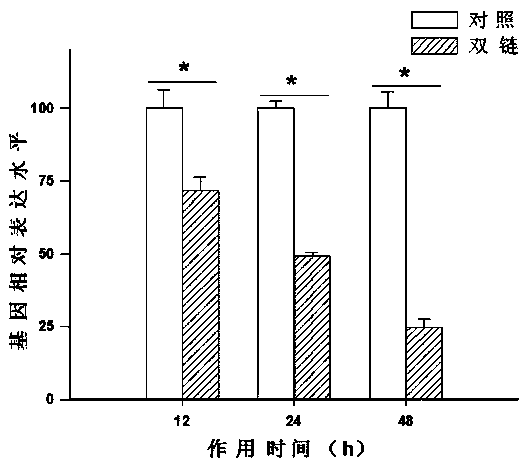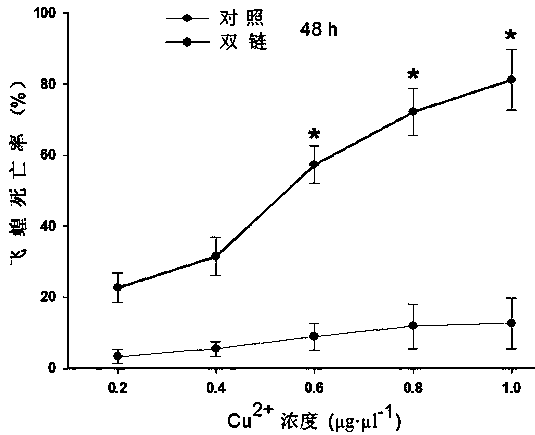Application of migratory locust metallothionein I-type gene LmMt I to grasshopper control
A metallothionein and migratory locust technology, which is applied in the biological field, can solve the problems of pesticide residues in agricultural products, harm of non-target organisms and natural enemy insects, and threats to insects, and achieves good specificity and high efficiency.
- Summary
- Abstract
- Description
- Claims
- Application Information
AI Technical Summary
Problems solved by technology
Method used
Image
Examples
Embodiment 1
[0017] The acquisition and application of the metallothionein type I gene (LmMt I) sequence of migratory locust;
[0018] After transcriptome sequencing and using bioinformatics methods to search for the metallothionein type I gene of migratory locust, the gene was cloned and verified by sequencing using the migratory locust DNA as a template, and the sequence SEQ ID NO of the gene (LmMt I) was confirmed: 1;
[0019] Select the gene fragment of the open reading frame SEQ ID NO: 2 in the sequence of SEQ ID NO: 1;
[0020] According to the sequence characteristics of SEQ ID NO: 2, the primer premier5.0 software was used to design the upper and lower primers SEQ ID NO: 3 and SEQ ID NO: 4 containing the T7 promoter, and then according to T7 RiboMAX TM Express RNAi System Kit Instructions In vitro transcription and synthesis of dsRNA;
[0021] Use 1% agarose gel electrophoresis to detect the singleness of dsRNA, and then quantify it as the final concentration: 1.5 μg / μl;
[002...
Embodiment 2
[0026] The application of the sequence of metallothionein type I gene (LmMt I) of migratory locust;
[0027] The method for synthesizing dsRNA is as described in Example 1;
[0028] After detecting and confirming the singleness of dsRNA, quantify it to a final concentration of 1.5 μg / μl;
[0029] Select 100 healthy 5th-instar nymphs of migratory locusts, and divide them into control group and experimental group equally. Inject 5 μl of specific dsRNA intraperitoneally into the experimental group insects with a microsyringe, and inject the same amount of dsGFP into the control group locusts. Finally, the insects were placed in a 27-degree climate box, fed and observed with fresh rice leaves;
[0030] 24 and 48 hours after dsRNA injection, 20 worms were taken to detect the silencing efficiency of dsRNA on LmMt I. The results showed that the silencing efficiency of LmMt I gene reached 74.7% at 48 hours after dsRNA injection;
[0031] After 36 hours of dsRNA injection by the abov...
Embodiment 3
[0033] The application of the sequence of metallothionein type I gene (LmMt I) of migratory locust;
[0034] The method for synthesizing dsRNA is as described in Example 1;
[0035] Quantify the dsRNA to a final concentration of 2.0 μg / μl;
[0036] Select 90 healthy adult migratory locusts and divide them into control group and experimental group. Inject 4 μl of dsRNA into the insects of the experimental group with a micro-injector, and inject the same amount of dsGFP into the insects of the control group, and then place them in a 29-degree climate box. rice leaf feeding;
[0037] After 24 and 48 hours, 20 worms were taken immediately to detect the silencing efficiency of LmMt I was 77.3%;
[0038] A series of abnormal physiological behaviors were found in migratory locusts 36-48 hours after dsRNA injection. After 12 hours of injection of low-concentration copper solution (0.3 μg / μl) into the abdomen, the mortality rate of migratory locusts increased significantly compared w...
PUM
 Login to View More
Login to View More Abstract
Description
Claims
Application Information
 Login to View More
Login to View More - R&D
- Intellectual Property
- Life Sciences
- Materials
- Tech Scout
- Unparalleled Data Quality
- Higher Quality Content
- 60% Fewer Hallucinations
Browse by: Latest US Patents, China's latest patents, Technical Efficacy Thesaurus, Application Domain, Technology Topic, Popular Technical Reports.
© 2025 PatSnap. All rights reserved.Legal|Privacy policy|Modern Slavery Act Transparency Statement|Sitemap|About US| Contact US: help@patsnap.com


